-
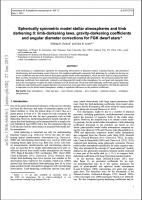 Spherically symmetric model stellar atmospheres and limb darkening II
Spherically symmetric model stellar atmospheres and limb darkening II The second journal article on stellar atmospheres and limb darkening by Hielding Nielson and John Lester. The abstract of the article states, "Limb darkening is a fundamental ingredient for interpreting observations of planetary transits, eclipsing binaries, optical/infrared interferometry and microlensing events. However, this modeling traditionally represents limb darkening by a simple law having one or two coefficients that have been derived from plane-parallel model stellar atmospheres, which has been done by many researchers. More recently, researchers have gone beyond plane-parallel models and considered other geometries. We previously studied the limb-darkening coefficients from spherically symmetric and plane-parallel model stellar atmospheres for cool giant and supergiant stars, and in this investigation we apply the same techniques to FGK dwarf stars. We present limb-darkening coefficients, gravity-darkening coefficients and interferometric angular diameter corrections from Atlas and SAtlas model stellar atmospheres. We find that sphericity is important even for dwarf model atmospheres, leading to significant differences in the predicted coefficients."
-
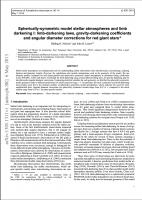 Spherically-symmetric model stellar atmospheres and limb darkening I
Spherically-symmetric model stellar atmospheres and limb darkening I The first journal article on stellar atmospheres and limb darkening by Hielding Nielson and John Lester. The abstrat to the article states, "Model stellar atmospheres are fundamental tools for understanding stellar observations from interferometry, microlensing, eclipsing binaries and planetary transits. However, the calculations also include assumptions, such as the geometry of the model. We use intensity profiles computed for both plane-parallel and spherically symmetric model atmospheres to determine fitting coefficients in the BVRIHK, CoRot and Kepler wavebands for limb darkening using several different fitting laws, for gravity-darkening and for interferometric angular diameter corrections. Comparing predicted variables for each geometry, we find that the spherically symmetric model geometry leads to different predictions for surface gravities log g < 3. In particular, the most commonly used limb-darkening laws produce poor fits to the intensity profiles of spherically symmetric model atmospheres, which indicates the need for more sophisticated laws. Angular diameter corrections for spherically symmetric models range from 0.67 to 1, compared to the much smaller range from 0.95 to 1 for plane-parallel models."
-
 The Slate Islands meteorite impact site: a study of shock remanent magnetization
The Slate Islands meteorite impact site: a study of shock remanent magnetization A journal article by Henry Halls on his wider research of the Slate Islands meteorite impact site, by conducting a paleomagnetic study of rock samples from Lake Superior. The abstract to the journal article states, "A detailed palaeomagnetic study of the Slate Islands meteorite impact site, northern Lake Superior, has successfully isolated a secondary component of remanence which on the basis of field relationships, models of impact crater formation and laboratory investigation appears to be a Shock Remanent Magnetization (SRM). Evidence for this hitherto rare type of naturally formed remanence is that: (a) the component is confined to rocks having experienced intense shock (50 to more than 100 kb) on the basis of shatter-cone development and the presence of planar features in quartz and felspar; (b) the component appears to have been acquired virtually instantaneously in terms of normal geological processes as a combined palaeomagnetic—shatter cone analysis suggests that it was formed within a time interval (perhaps several minutes in duration) between the moment of impact and the formation of the central uplift; (c) the extent of magnetic resetting decreases with increasing distance from the centre of the impact site; and (d) the degree of resetting increases with the abundance of low coercivity magnetic grains as given by Hcr, a relationship found by other investigators for experimentally-produced SRM. Intrusive breccias found on the islands yield a secondary component of TRM or TRCM origin which was frozen in after central uplift formation. Increased convergence of shatter cone axes to a central focus after rotation of host rock blocks according to palaeomagnetic data, suggests that the SRM had the same direction as that found in the breccias and hence was aligned with the ambient field at the time of impact."
-
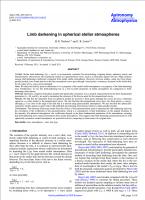 Limb darkening in spherical stellar atmospheres
Limb darkening in spherical stellar atmospheres Stellar limb darkening, I(μ = cosθ), is an important constraint for microlensing, eclipsing binary, planetary transit, and interferometric observations, but is generally treated as a parameterized curve, such as a linear-plus-square-root law. Many analyses assume limb-darkening coefficients computed from model stellar atmospheres. However, previous studies, using I(μ) from plane-parallel models, have found that fits to the flux-normalized curves pass through a fixed point, a common μ location on the stellar disk, for all values of Teff, log g and wavelength. Aims. We study this fixed μ-point to determine if it is a property of the model stellar atmospheres or a property of the limb-darkening laws. Furthermore, we use this limb-darkening law as a tool to probe properties of stellar atmospheres for comparison to limb-darkening observations.
-
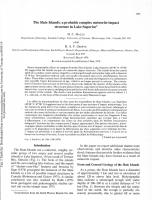 The Slate Islands: a probable complex meteorite impact structure in Lake Superior
The Slate Islands: a probable complex meteorite impact structure in Lake Superior Shock metamorphic effects in samples from the Slate Islands, Lake Superior (48°40' N, 87°00' W) suggest that the islands are part of a meteorite impact structure. The islands form the central uplift of a complex crater and are ringed by a submerged trough and annular ridge with a diameter of 30 km. Precambrian bedrock units are locally brecciated and cut by allochthonous breccia dikes. These dikes contain clasts of identifiable country rock and also fragments of a sedimentary unit, possibly Upper Keweenawan in age, which is no longer present in outcrop. The orienta tions of shatter-cones present in the breccia host-rocks indicate the interior of the islands as the approximate shock centre. Microscopic planar features, equivalent to those described from other impact sites, occur in quartz and plagioclase and the level of shock deformation increases towards the interior of the islands. The shock event postdates Keweenawan igneous activity (about 1.1 b.y. old) and, on the basis of the erosion level, may be early Paleozoic in age.
-
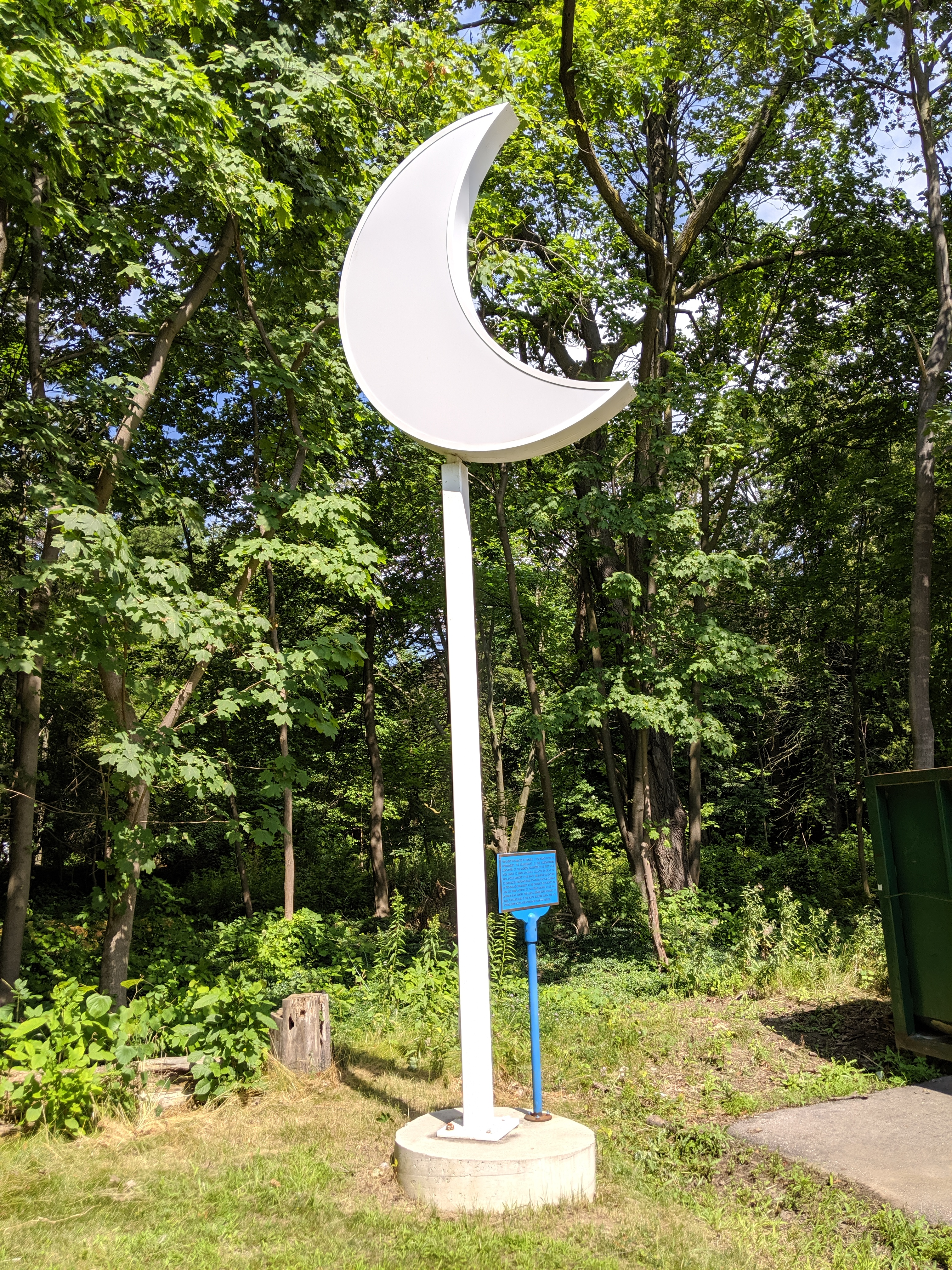 Lunar Light
Lunar Light The Lunar Light was erected by Principal John Tuzo Wilson, outside the Paleomagnetism Laboratory in 1973 to commemorate the research of the lunar rock samples. The light and accompanying plaque still stands today. The plague reads "This light was erected by Principal J. Tuzo Wilson in 1973 to commemorate the measurement, in the Paleomagnetism Laboratory, of the magnetic properties of the first lunar rock sample to arrive in Canada. Collected by one of the NASA Apollo missions to the moon, the sample was brought to Erindale by Professor David Strangway who was Chairman of the Geology Department at the University of Toronto and also the Chief Scientist of the Physics Branch at the NASA Johnson Space Centre. The sample, before being returned to NASA, was displayed in the South Building during the 1973 science open house attracting more than 4000 viewers."
-
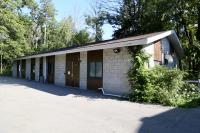 Paleomagnetism Laboratory
Paleomagnetism Laboratory The Paleomagnetism Laboratory, originally the Physical Properties Laboratory, was constructed in 1969 to study the magnetic properties of rock samples. It was famous for conducting research of the lunar rock samples from the Apollo 11 mission and samples from the meteorite impact site at the Slate Islands on Lake Superior. It was constructed of aluminum, brass, concrete, and wood to further reduce the Earth's magnetic interference. The building, also know as the "lunar lab" or "rock lab" still stands on campus along the Principal’s Road on the way to Lislehurst, the Principal's Residence. The Paleomagnetism Laboratory was closed on 22 May 2019.
-
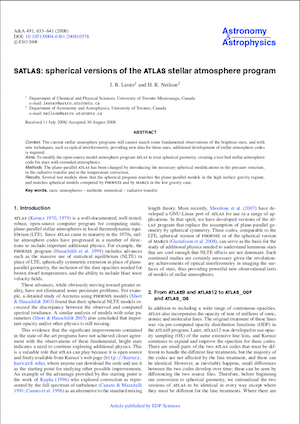 SATLAS: Spherical versions of the ATLAS stellar atmosphere program
SATLAS: Spherical versions of the ATLAS stellar atmosphere program This journal article was written by John Lester and Hielding Neilson in their research of stellar atmosphere techniques. The abstract to the article states, "The current stellar atmosphere programs still cannot match some fundamental observations of the brightest stars, and with new techniques, such as optical interferometry, providing new data for these stars, additional development of stellar atmosphere codes is required. Aims: To modify the open-source model atmosphere program Atlas to treat spherical geometry, creating a test-bed stellar atmosphere code for stars with extended atmospheres."
-
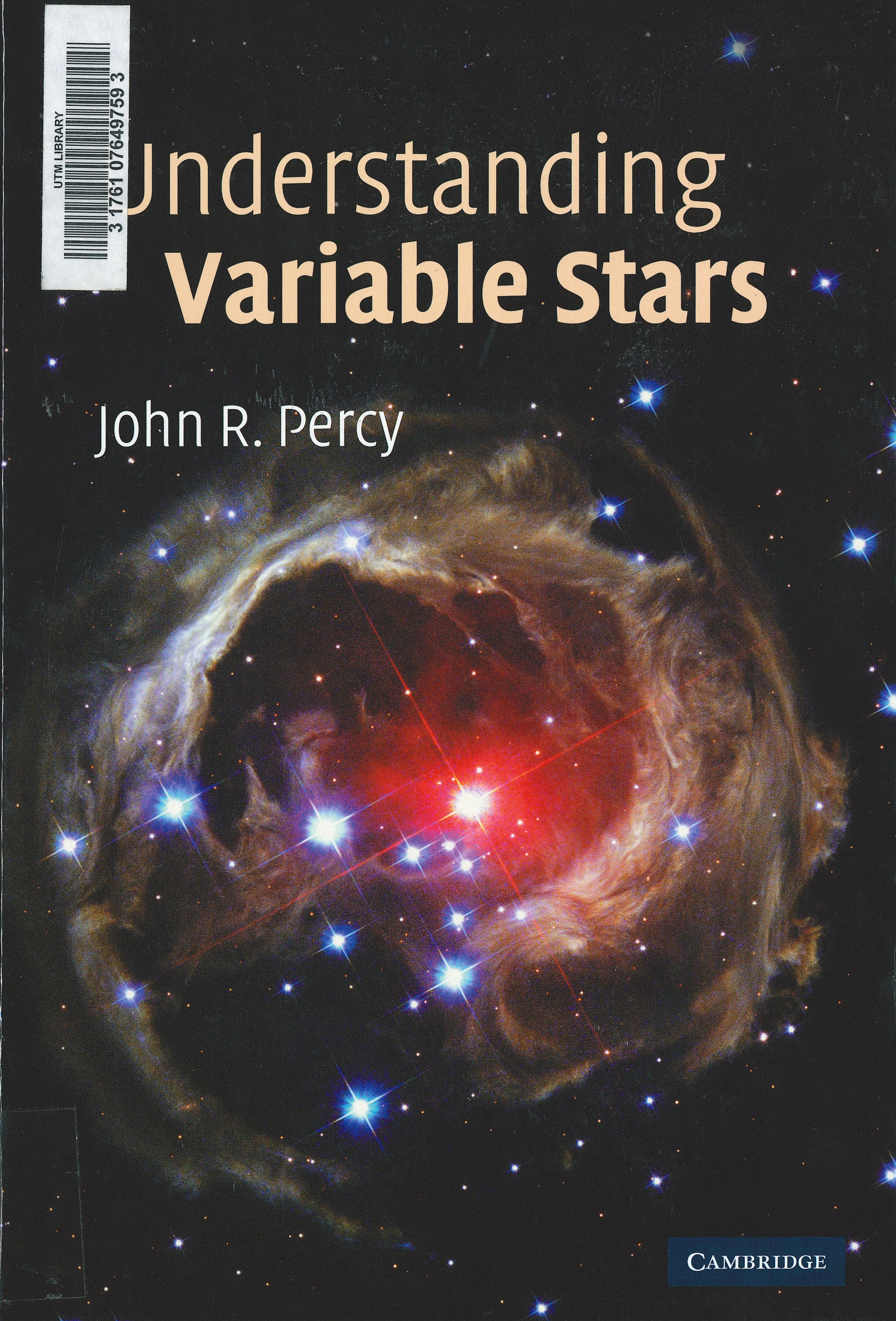 Understanding Variable Stars
Understanding Variable Stars This book was written by John Percy which provides a comprehensive overview of variable star research. The publisher's description of the book reads, "Variable stars are those that change brightness. Their variability may be due to geometric processes such as rotation, or eclipse by a companion star, or physical processes such as vibration, flares, or cataclysmic explosions. In each case, variable stars provide unique information about the properties of stars, and the processes that go on within them. This book provides a concise overview of variable stars, including a historical perspective, an introduction to stars in general, the techniques for discovering and studying variable stars, and a description of the main types of variable stars. It ends with short reflections about the connection between the study of variable stars, and research, education, amateur astronomy, and public interest in astronomy. This book is intended for anyone with some background knowledge of astronomy, but is especially suitable for undergraduate students and experienced amateur astronomers who can contribute to our understanding of these important stars."
-
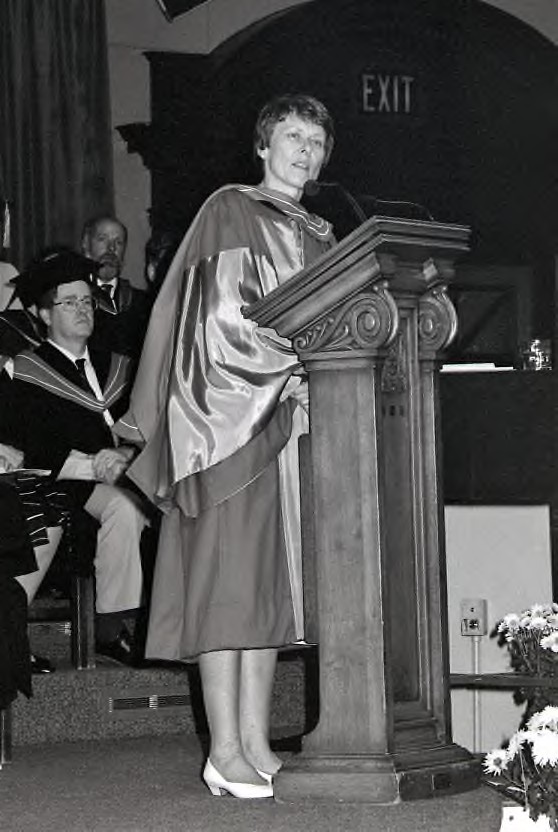 Honorary degree recipient, Astronaut Roberta Bondar
Honorary degree recipient, Astronaut Roberta Bondar Honorary degree recipient, Astronaut Roberta Bondar speaking at UTM convocation June, 1992.
-
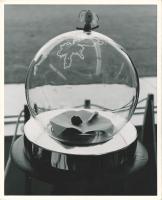 Moon Rocks Globe
Moon Rocks Globe Glass globe containing moon rock samples from the first public showing in Canada of the moon samples from 11-12 October 1969 in the North Building of Erindale College before they were relocated to the newly-built Physical Properties Laboratory, now Paleomagnetism Laboratory, for geological research. When the first lunar samples arrived and were exhibited, more than 3,000 people lined up for a peek at a moon rock no bigger than a golf ball and a thimbleful of moondust.
-
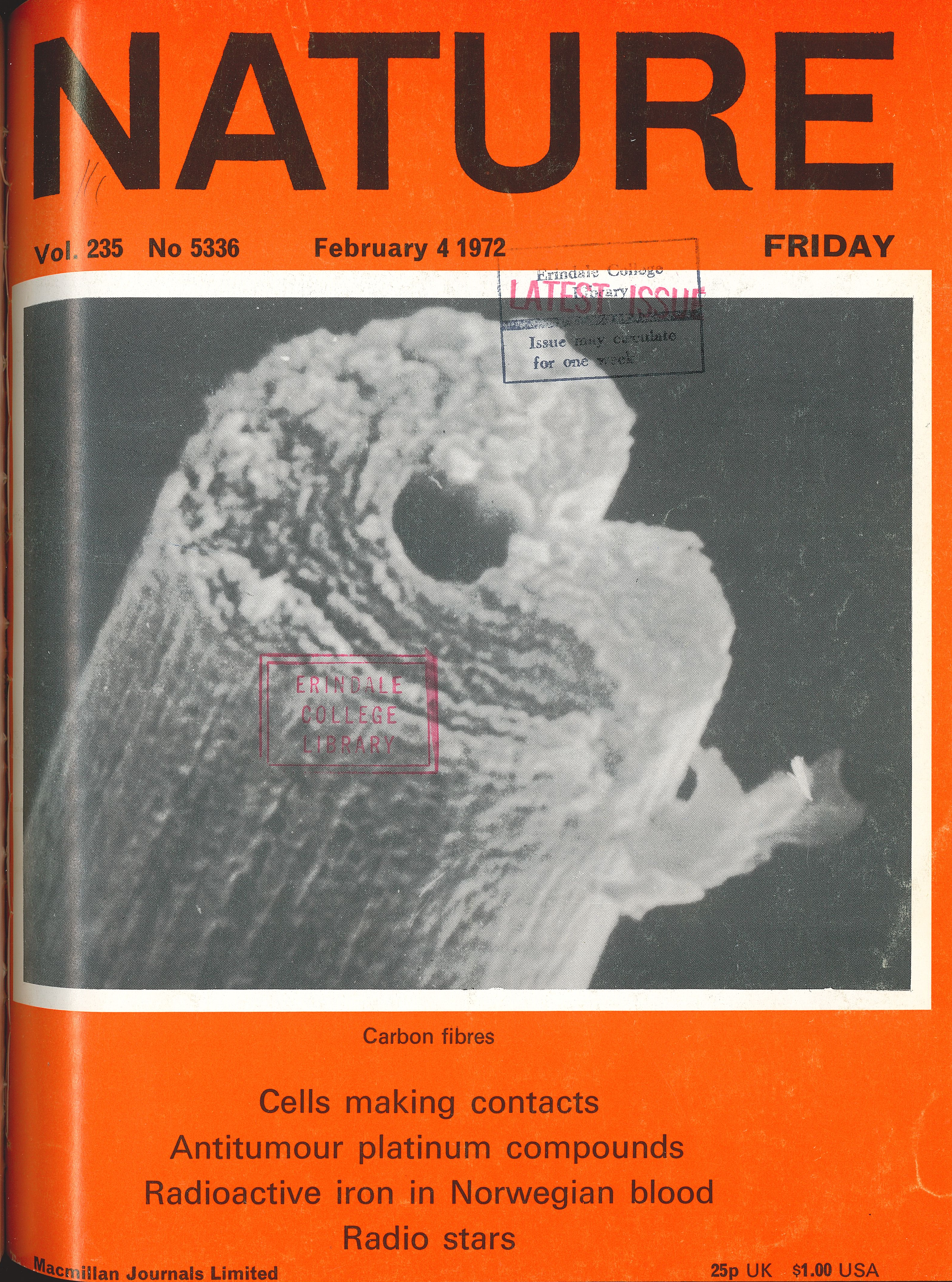 Identification of Cygnus X-1 with HDE 226868
Identification of Cygnus X-1 with HDE 226868 The first of two important journal articles by Tom Bolton on the discovery of the first black hole at Cygnus X-1. The abstract to the article states, "The ninth magnitude BOIb star HDE 226868 is closely coincident with the position of Cygnus X-1 and its associated variable radio source1. Dolan2 has pointed out that Cyg X-1 appears to be a two component X-ray source. One component has a synchrotron spectrum, and the other has a thermal (or bremsstrahlung) spectrum. The latter component varies on a time scale of days in a way that suggests it is being eclipsed. Therefore I decided to take photographic spectra of HDE 226868 to look for velocity and spectrum variations that might be correlated with the X-ray fluctuations. I find that the velocity of the star varies with a period consistent with that of the X-ray variation. It may not be possible, however, to interpret the X-ray variations in terms of simple eclipses."
-
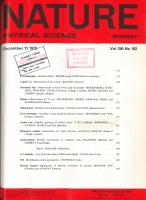 Dimensions of the Binary System HDE 226868 = Cygnus X-1
Dimensions of the Binary System HDE 226868 = Cygnus X-1 The second important journal article on the first scientific evidence of a black hole at Cygnus X-1. The abstract to the . article states, "Recent observations of the binary star HDE 226868, which is believed to be associated with Cygnus X-1, are here combined with data already published to obtain improved orbital elements for the binary system. The data imply that the secondary is a black hole."
-
 Moon rock display at Erindale College
Moon rock display at Erindale College Photograph of Irving Spiegel, David Strangway, J. Tuzo Wilson, and E.A. Robinson from the first public showing in Canada of the moon samples from 11-12 October 1969 in the North Building of Erindale College before they were relocated to the newly-built Physical Properties Laboratory, now Paleomagnetism Laboratory, for geological research. When the first lunar samples arrived and were exhibited, more than 3,000 people lined up for a peek at a moon rock no bigger than a golf ball and a thimbleful of moondust.
-
 UTM, 25th anniversary, alumnus Astronaut Roberta Bondar gives photo
UTM, 25th anniversary, alumnus Astronaut Roberta Bondar gives photo A photograph signed by Roberta Bondar. Inscription on photo reads: "Erindale With very best wishes Roberta Bondar Jun 24 1992".
 Spherically symmetric model stellar atmospheres and limb darkening II The second journal article on stellar atmospheres and limb darkening by Hielding Nielson and John Lester. The abstract of the article states, "Limb darkening is a fundamental ingredient for interpreting observations of planetary transits, eclipsing binaries, optical/infrared interferometry and microlensing events. However, this modeling traditionally represents limb darkening by a simple law having one or two coefficients that have been derived from plane-parallel model stellar atmospheres, which has been done by many researchers. More recently, researchers have gone beyond plane-parallel models and considered other geometries. We previously studied the limb-darkening coefficients from spherically symmetric and plane-parallel model stellar atmospheres for cool giant and supergiant stars, and in this investigation we apply the same techniques to FGK dwarf stars. We present limb-darkening coefficients, gravity-darkening coefficients and interferometric angular diameter corrections from Atlas and SAtlas model stellar atmospheres. We find that sphericity is important even for dwarf model atmospheres, leading to significant differences in the predicted coefficients."
Spherically symmetric model stellar atmospheres and limb darkening II The second journal article on stellar atmospheres and limb darkening by Hielding Nielson and John Lester. The abstract of the article states, "Limb darkening is a fundamental ingredient for interpreting observations of planetary transits, eclipsing binaries, optical/infrared interferometry and microlensing events. However, this modeling traditionally represents limb darkening by a simple law having one or two coefficients that have been derived from plane-parallel model stellar atmospheres, which has been done by many researchers. More recently, researchers have gone beyond plane-parallel models and considered other geometries. We previously studied the limb-darkening coefficients from spherically symmetric and plane-parallel model stellar atmospheres for cool giant and supergiant stars, and in this investigation we apply the same techniques to FGK dwarf stars. We present limb-darkening coefficients, gravity-darkening coefficients and interferometric angular diameter corrections from Atlas and SAtlas model stellar atmospheres. We find that sphericity is important even for dwarf model atmospheres, leading to significant differences in the predicted coefficients." Spherically-symmetric model stellar atmospheres and limb darkening I The first journal article on stellar atmospheres and limb darkening by Hielding Nielson and John Lester. The abstrat to the article states, "Model stellar atmospheres are fundamental tools for understanding stellar observations from interferometry, microlensing, eclipsing binaries and planetary transits. However, the calculations also include assumptions, such as the geometry of the model. We use intensity profiles computed for both plane-parallel and spherically symmetric model atmospheres to determine fitting coefficients in the BVRIHK, CoRot and Kepler wavebands for limb darkening using several different fitting laws, for gravity-darkening and for interferometric angular diameter corrections. Comparing predicted variables for each geometry, we find that the spherically symmetric model geometry leads to different predictions for surface gravities log g < 3. In particular, the most commonly used limb-darkening laws produce poor fits to the intensity profiles of spherically symmetric model atmospheres, which indicates the need for more sophisticated laws. Angular diameter corrections for spherically symmetric models range from 0.67 to 1, compared to the much smaller range from 0.95 to 1 for plane-parallel models."
Spherically-symmetric model stellar atmospheres and limb darkening I The first journal article on stellar atmospheres and limb darkening by Hielding Nielson and John Lester. The abstrat to the article states, "Model stellar atmospheres are fundamental tools for understanding stellar observations from interferometry, microlensing, eclipsing binaries and planetary transits. However, the calculations also include assumptions, such as the geometry of the model. We use intensity profiles computed for both plane-parallel and spherically symmetric model atmospheres to determine fitting coefficients in the BVRIHK, CoRot and Kepler wavebands for limb darkening using several different fitting laws, for gravity-darkening and for interferometric angular diameter corrections. Comparing predicted variables for each geometry, we find that the spherically symmetric model geometry leads to different predictions for surface gravities log g < 3. In particular, the most commonly used limb-darkening laws produce poor fits to the intensity profiles of spherically symmetric model atmospheres, which indicates the need for more sophisticated laws. Angular diameter corrections for spherically symmetric models range from 0.67 to 1, compared to the much smaller range from 0.95 to 1 for plane-parallel models." The Slate Islands meteorite impact site: a study of shock remanent magnetization A journal article by Henry Halls on his wider research of the Slate Islands meteorite impact site, by conducting a paleomagnetic study of rock samples from Lake Superior. The abstract to the journal article states, "A detailed palaeomagnetic study of the Slate Islands meteorite impact site, northern Lake Superior, has successfully isolated a secondary component of remanence which on the basis of field relationships, models of impact crater formation and laboratory investigation appears to be a Shock Remanent Magnetization (SRM). Evidence for this hitherto rare type of naturally formed remanence is that: (a) the component is confined to rocks having experienced intense shock (50 to more than 100 kb) on the basis of shatter-cone development and the presence of planar features in quartz and felspar; (b) the component appears to have been acquired virtually instantaneously in terms of normal geological processes as a combined palaeomagnetic—shatter cone analysis suggests that it was formed within a time interval (perhaps several minutes in duration) between the moment of impact and the formation of the central uplift; (c) the extent of magnetic resetting decreases with increasing distance from the centre of the impact site; and (d) the degree of resetting increases with the abundance of low coercivity magnetic grains as given by Hcr, a relationship found by other investigators for experimentally-produced SRM. Intrusive breccias found on the islands yield a secondary component of TRM or TRCM origin which was frozen in after central uplift formation. Increased convergence of shatter cone axes to a central focus after rotation of host rock blocks according to palaeomagnetic data, suggests that the SRM had the same direction as that found in the breccias and hence was aligned with the ambient field at the time of impact."
The Slate Islands meteorite impact site: a study of shock remanent magnetization A journal article by Henry Halls on his wider research of the Slate Islands meteorite impact site, by conducting a paleomagnetic study of rock samples from Lake Superior. The abstract to the journal article states, "A detailed palaeomagnetic study of the Slate Islands meteorite impact site, northern Lake Superior, has successfully isolated a secondary component of remanence which on the basis of field relationships, models of impact crater formation and laboratory investigation appears to be a Shock Remanent Magnetization (SRM). Evidence for this hitherto rare type of naturally formed remanence is that: (a) the component is confined to rocks having experienced intense shock (50 to more than 100 kb) on the basis of shatter-cone development and the presence of planar features in quartz and felspar; (b) the component appears to have been acquired virtually instantaneously in terms of normal geological processes as a combined palaeomagnetic—shatter cone analysis suggests that it was formed within a time interval (perhaps several minutes in duration) between the moment of impact and the formation of the central uplift; (c) the extent of magnetic resetting decreases with increasing distance from the centre of the impact site; and (d) the degree of resetting increases with the abundance of low coercivity magnetic grains as given by Hcr, a relationship found by other investigators for experimentally-produced SRM. Intrusive breccias found on the islands yield a secondary component of TRM or TRCM origin which was frozen in after central uplift formation. Increased convergence of shatter cone axes to a central focus after rotation of host rock blocks according to palaeomagnetic data, suggests that the SRM had the same direction as that found in the breccias and hence was aligned with the ambient field at the time of impact." Limb darkening in spherical stellar atmospheres Stellar limb darkening, I(μ = cosθ), is an important constraint for microlensing, eclipsing binary, planetary transit, and interferometric observations, but is generally treated as a parameterized curve, such as a linear-plus-square-root law. Many analyses assume limb-darkening coefficients computed from model stellar atmospheres. However, previous studies, using I(μ) from plane-parallel models, have found that fits to the flux-normalized curves pass through a fixed point, a common μ location on the stellar disk, for all values of Teff, log g and wavelength. Aims. We study this fixed μ-point to determine if it is a property of the model stellar atmospheres or a property of the limb-darkening laws. Furthermore, we use this limb-darkening law as a tool to probe properties of stellar atmospheres for comparison to limb-darkening observations.
Limb darkening in spherical stellar atmospheres Stellar limb darkening, I(μ = cosθ), is an important constraint for microlensing, eclipsing binary, planetary transit, and interferometric observations, but is generally treated as a parameterized curve, such as a linear-plus-square-root law. Many analyses assume limb-darkening coefficients computed from model stellar atmospheres. However, previous studies, using I(μ) from plane-parallel models, have found that fits to the flux-normalized curves pass through a fixed point, a common μ location on the stellar disk, for all values of Teff, log g and wavelength. Aims. We study this fixed μ-point to determine if it is a property of the model stellar atmospheres or a property of the limb-darkening laws. Furthermore, we use this limb-darkening law as a tool to probe properties of stellar atmospheres for comparison to limb-darkening observations. The Slate Islands: a probable complex meteorite impact structure in Lake Superior Shock metamorphic effects in samples from the Slate Islands, Lake Superior (48°40' N, 87°00' W) suggest that the islands are part of a meteorite impact structure. The islands form the central uplift of a complex crater and are ringed by a submerged trough and annular ridge with a diameter of 30 km. Precambrian bedrock units are locally brecciated and cut by allochthonous breccia dikes. These dikes contain clasts of identifiable country rock and also fragments of a sedimentary unit, possibly Upper Keweenawan in age, which is no longer present in outcrop. The orienta tions of shatter-cones present in the breccia host-rocks indicate the interior of the islands as the approximate shock centre. Microscopic planar features, equivalent to those described from other impact sites, occur in quartz and plagioclase and the level of shock deformation increases towards the interior of the islands. The shock event postdates Keweenawan igneous activity (about 1.1 b.y. old) and, on the basis of the erosion level, may be early Paleozoic in age.
The Slate Islands: a probable complex meteorite impact structure in Lake Superior Shock metamorphic effects in samples from the Slate Islands, Lake Superior (48°40' N, 87°00' W) suggest that the islands are part of a meteorite impact structure. The islands form the central uplift of a complex crater and are ringed by a submerged trough and annular ridge with a diameter of 30 km. Precambrian bedrock units are locally brecciated and cut by allochthonous breccia dikes. These dikes contain clasts of identifiable country rock and also fragments of a sedimentary unit, possibly Upper Keweenawan in age, which is no longer present in outcrop. The orienta tions of shatter-cones present in the breccia host-rocks indicate the interior of the islands as the approximate shock centre. Microscopic planar features, equivalent to those described from other impact sites, occur in quartz and plagioclase and the level of shock deformation increases towards the interior of the islands. The shock event postdates Keweenawan igneous activity (about 1.1 b.y. old) and, on the basis of the erosion level, may be early Paleozoic in age. Lunar Light The Lunar Light was erected by Principal John Tuzo Wilson, outside the Paleomagnetism Laboratory in 1973 to commemorate the research of the lunar rock samples. The light and accompanying plaque still stands today. The plague reads "This light was erected by Principal J. Tuzo Wilson in 1973 to commemorate the measurement, in the Paleomagnetism Laboratory, of the magnetic properties of the first lunar rock sample to arrive in Canada. Collected by one of the NASA Apollo missions to the moon, the sample was brought to Erindale by Professor David Strangway who was Chairman of the Geology Department at the University of Toronto and also the Chief Scientist of the Physics Branch at the NASA Johnson Space Centre. The sample, before being returned to NASA, was displayed in the South Building during the 1973 science open house attracting more than 4000 viewers."
Lunar Light The Lunar Light was erected by Principal John Tuzo Wilson, outside the Paleomagnetism Laboratory in 1973 to commemorate the research of the lunar rock samples. The light and accompanying plaque still stands today. The plague reads "This light was erected by Principal J. Tuzo Wilson in 1973 to commemorate the measurement, in the Paleomagnetism Laboratory, of the magnetic properties of the first lunar rock sample to arrive in Canada. Collected by one of the NASA Apollo missions to the moon, the sample was brought to Erindale by Professor David Strangway who was Chairman of the Geology Department at the University of Toronto and also the Chief Scientist of the Physics Branch at the NASA Johnson Space Centre. The sample, before being returned to NASA, was displayed in the South Building during the 1973 science open house attracting more than 4000 viewers." Paleomagnetism Laboratory The Paleomagnetism Laboratory, originally the Physical Properties Laboratory, was constructed in 1969 to study the magnetic properties of rock samples. It was famous for conducting research of the lunar rock samples from the Apollo 11 mission and samples from the meteorite impact site at the Slate Islands on Lake Superior. It was constructed of aluminum, brass, concrete, and wood to further reduce the Earth's magnetic interference. The building, also know as the "lunar lab" or "rock lab" still stands on campus along the Principal’s Road on the way to Lislehurst, the Principal's Residence. The Paleomagnetism Laboratory was closed on 22 May 2019.
Paleomagnetism Laboratory The Paleomagnetism Laboratory, originally the Physical Properties Laboratory, was constructed in 1969 to study the magnetic properties of rock samples. It was famous for conducting research of the lunar rock samples from the Apollo 11 mission and samples from the meteorite impact site at the Slate Islands on Lake Superior. It was constructed of aluminum, brass, concrete, and wood to further reduce the Earth's magnetic interference. The building, also know as the "lunar lab" or "rock lab" still stands on campus along the Principal’s Road on the way to Lislehurst, the Principal's Residence. The Paleomagnetism Laboratory was closed on 22 May 2019. SATLAS: Spherical versions of the ATLAS stellar atmosphere program This journal article was written by John Lester and Hielding Neilson in their research of stellar atmosphere techniques. The abstract to the article states, "The current stellar atmosphere programs still cannot match some fundamental observations of the brightest stars, and with new techniques, such as optical interferometry, providing new data for these stars, additional development of stellar atmosphere codes is required. Aims: To modify the open-source model atmosphere program Atlas to treat spherical geometry, creating a test-bed stellar atmosphere code for stars with extended atmospheres."
SATLAS: Spherical versions of the ATLAS stellar atmosphere program This journal article was written by John Lester and Hielding Neilson in their research of stellar atmosphere techniques. The abstract to the article states, "The current stellar atmosphere programs still cannot match some fundamental observations of the brightest stars, and with new techniques, such as optical interferometry, providing new data for these stars, additional development of stellar atmosphere codes is required. Aims: To modify the open-source model atmosphere program Atlas to treat spherical geometry, creating a test-bed stellar atmosphere code for stars with extended atmospheres." Understanding Variable Stars This book was written by John Percy which provides a comprehensive overview of variable star research. The publisher's description of the book reads, "Variable stars are those that change brightness. Their variability may be due to geometric processes such as rotation, or eclipse by a companion star, or physical processes such as vibration, flares, or cataclysmic explosions. In each case, variable stars provide unique information about the properties of stars, and the processes that go on within them. This book provides a concise overview of variable stars, including a historical perspective, an introduction to stars in general, the techniques for discovering and studying variable stars, and a description of the main types of variable stars. It ends with short reflections about the connection between the study of variable stars, and research, education, amateur astronomy, and public interest in astronomy. This book is intended for anyone with some background knowledge of astronomy, but is especially suitable for undergraduate students and experienced amateur astronomers who can contribute to our understanding of these important stars."
Understanding Variable Stars This book was written by John Percy which provides a comprehensive overview of variable star research. The publisher's description of the book reads, "Variable stars are those that change brightness. Their variability may be due to geometric processes such as rotation, or eclipse by a companion star, or physical processes such as vibration, flares, or cataclysmic explosions. In each case, variable stars provide unique information about the properties of stars, and the processes that go on within them. This book provides a concise overview of variable stars, including a historical perspective, an introduction to stars in general, the techniques for discovering and studying variable stars, and a description of the main types of variable stars. It ends with short reflections about the connection between the study of variable stars, and research, education, amateur astronomy, and public interest in astronomy. This book is intended for anyone with some background knowledge of astronomy, but is especially suitable for undergraduate students and experienced amateur astronomers who can contribute to our understanding of these important stars." Honorary degree recipient, Astronaut Roberta Bondar Honorary degree recipient, Astronaut Roberta Bondar speaking at UTM convocation June, 1992.
Honorary degree recipient, Astronaut Roberta Bondar Honorary degree recipient, Astronaut Roberta Bondar speaking at UTM convocation June, 1992. Moon Rocks Globe Glass globe containing moon rock samples from the first public showing in Canada of the moon samples from 11-12 October 1969 in the North Building of Erindale College before they were relocated to the newly-built Physical Properties Laboratory, now Paleomagnetism Laboratory, for geological research. When the first lunar samples arrived and were exhibited, more than 3,000 people lined up for a peek at a moon rock no bigger than a golf ball and a thimbleful of moondust.
Moon Rocks Globe Glass globe containing moon rock samples from the first public showing in Canada of the moon samples from 11-12 October 1969 in the North Building of Erindale College before they were relocated to the newly-built Physical Properties Laboratory, now Paleomagnetism Laboratory, for geological research. When the first lunar samples arrived and were exhibited, more than 3,000 people lined up for a peek at a moon rock no bigger than a golf ball and a thimbleful of moondust. Identification of Cygnus X-1 with HDE 226868 The first of two important journal articles by Tom Bolton on the discovery of the first black hole at Cygnus X-1. The abstract to the article states, "The ninth magnitude BOIb star HDE 226868 is closely coincident with the position of Cygnus X-1 and its associated variable radio source1. Dolan2 has pointed out that Cyg X-1 appears to be a two component X-ray source. One component has a synchrotron spectrum, and the other has a thermal (or bremsstrahlung) spectrum. The latter component varies on a time scale of days in a way that suggests it is being eclipsed. Therefore I decided to take photographic spectra of HDE 226868 to look for velocity and spectrum variations that might be correlated with the X-ray fluctuations. I find that the velocity of the star varies with a period consistent with that of the X-ray variation. It may not be possible, however, to interpret the X-ray variations in terms of simple eclipses."
Identification of Cygnus X-1 with HDE 226868 The first of two important journal articles by Tom Bolton on the discovery of the first black hole at Cygnus X-1. The abstract to the article states, "The ninth magnitude BOIb star HDE 226868 is closely coincident with the position of Cygnus X-1 and its associated variable radio source1. Dolan2 has pointed out that Cyg X-1 appears to be a two component X-ray source. One component has a synchrotron spectrum, and the other has a thermal (or bremsstrahlung) spectrum. The latter component varies on a time scale of days in a way that suggests it is being eclipsed. Therefore I decided to take photographic spectra of HDE 226868 to look for velocity and spectrum variations that might be correlated with the X-ray fluctuations. I find that the velocity of the star varies with a period consistent with that of the X-ray variation. It may not be possible, however, to interpret the X-ray variations in terms of simple eclipses." Dimensions of the Binary System HDE 226868 = Cygnus X-1 The second important journal article on the first scientific evidence of a black hole at Cygnus X-1. The abstract to the . article states, "Recent observations of the binary star HDE 226868, which is believed to be associated with Cygnus X-1, are here combined with data already published to obtain improved orbital elements for the binary system. The data imply that the secondary is a black hole."
Dimensions of the Binary System HDE 226868 = Cygnus X-1 The second important journal article on the first scientific evidence of a black hole at Cygnus X-1. The abstract to the . article states, "Recent observations of the binary star HDE 226868, which is believed to be associated with Cygnus X-1, are here combined with data already published to obtain improved orbital elements for the binary system. The data imply that the secondary is a black hole." Moon rock display at Erindale College Photograph of Irving Spiegel, David Strangway, J. Tuzo Wilson, and E.A. Robinson from the first public showing in Canada of the moon samples from 11-12 October 1969 in the North Building of Erindale College before they were relocated to the newly-built Physical Properties Laboratory, now Paleomagnetism Laboratory, for geological research. When the first lunar samples arrived and were exhibited, more than 3,000 people lined up for a peek at a moon rock no bigger than a golf ball and a thimbleful of moondust.
Moon rock display at Erindale College Photograph of Irving Spiegel, David Strangway, J. Tuzo Wilson, and E.A. Robinson from the first public showing in Canada of the moon samples from 11-12 October 1969 in the North Building of Erindale College before they were relocated to the newly-built Physical Properties Laboratory, now Paleomagnetism Laboratory, for geological research. When the first lunar samples arrived and were exhibited, more than 3,000 people lined up for a peek at a moon rock no bigger than a golf ball and a thimbleful of moondust. UTM, 25th anniversary, alumnus Astronaut Roberta Bondar gives photo A photograph signed by Roberta Bondar. Inscription on photo reads: "Erindale With very best wishes Roberta Bondar Jun 24 1992".
UTM, 25th anniversary, alumnus Astronaut Roberta Bondar gives photo A photograph signed by Roberta Bondar. Inscription on photo reads: "Erindale With very best wishes Roberta Bondar Jun 24 1992".